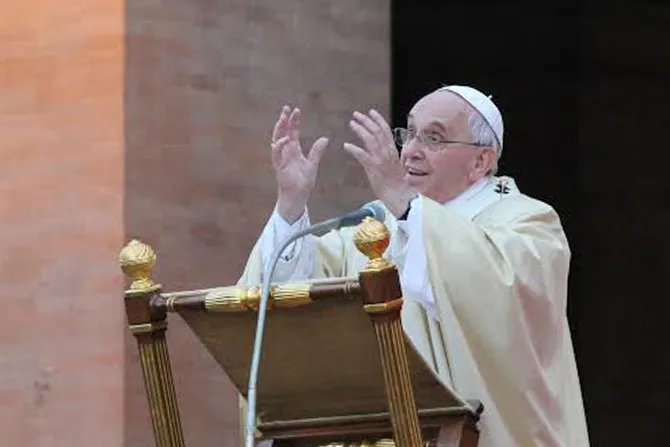Rome, Italy, Nov 1, 2014 / 11:30 am
During Mass for the Solemnity of All Saints at Rome's Verano cemetery, Pope Francis exhorted believers to follow the way of the beatitudes, calling it the path that will lead to sanctity.
"The people who go forward on the path of the beatitudes will reach God and become saints in that final meeting with Him," the Holy Father said Nov. 1, Vatican Radio reported.
He said, "in order to journey back to God the Father, in this world of devastation, of wars, of tribulation, we must act according to the beatitudes."
"This path will lead us through problems and persecution, but only this path will lead us forward."
In his homily, he spoke off the cuff about today's first reading from the book of the Apocalypse focusing on three images: a warning about earth's destruction, the multitude who appears before God and God himself.
Speaking about the second image offered in the reading – the innumerable crowd standing before God – the Holy Father drew attention to the unknown saints.
"Those who come from great tribulation in the many parts of the world. The Lord sanctifies these people through tribulation."
While at the cemetery, the Holy Father also blessed tombs and exposed relics of Saints John XXIII and John Paul II.
"In visiting Rome's main cemetery, I am united in spirit with those who in these days visit the graves of their dead in cemeteries around the world," the Pope said following his recitation of the Angelus earlier that morning in St. Peter's Square.
His visit to Campo Verano is the second time he has traveled to the cemetery since his election, the first being to celebrate the same feast last year.
Located in the Tiburtino neighborhood of Rome, which is close to the Basilica of Saint Lawrence Outside the Walls, the cemetery was created in the early nineteenth century, and is currently divided into different sections.
The different sections of the cemetery include a Jewish cemetery, a Catholic cemetery, and a monument to victims of the First World War, the centenary of which is celebrated this year.
Campo Verano takes its name from a prestigious family, the "Verini," who had lived there at the time of the Roman Republic, Vatican Radio reports.
According to the Vatican news service, the cemetery has been a burial site since ancient Roman times, and owes its striking appearance and unique layout to Giuseppe Valadier, a well-known Italian architect.
With the area originally containing ancient Christian catacombs, the modern cemetery was consecrated in 1835, and work on it continued under the guidance of Virginio Vespignani during the pontificates of Gregory XVI and Pius IX.
Vatican Radio reports that the cemetery was partially bombed by Allied forces in 1943, which led to the restoration work that established the three large entrances and four marble statues depicting meditation, hope, charity and silence that can be seen today.
(Story continues below)


